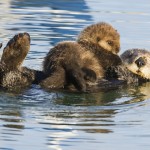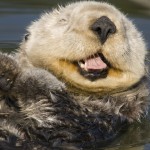Location: Moss Landing, California
Price: $900
Deposit: $250
Maximum Number of Participants: 8
Sea Otters are some of the most charismatic animals we have here in California. The goal of this sea otter photography workshop is to get photographers opportunities to photograph these cute animals from both land and from the water. We will take pictures of bachelor rafts, animals feeding, and animals wrapped up in kelp, from a privately chartered boat and from land. If you’d like to see and photograph these marine mammals along with a slough of other wildlife, this workshop is for you. This is by far my most popular workshop, so sign-up quick!
Required Photo Equipment:
– Camera (Digital SLR Camera preferred)
– Telephoto Lens (200 and above is recommended, 400 through 800mm range is best) *
Optional Photo Equipment:
– Wide angle lens
– Monopod
– Teleconverters
What to Bring
Clothing: California has a Mediterranean climate which means that the mornings are rather cold while the afternoon gets hot. This means it’s best to wear lots of layers that can be taken on and off during the day. Also bring a rain jacket and rain pants if you have them . If you are prone to getting cold, you may want to bring a beanie and gloves (and hand warmers).
Shoes: Running shoes, boat shoes, or Tevas.
Camera Gear Protection: You can bring a towel to wipe down cameras from mist, but waters are always so calm there is generally no danger of any exposure to it.
Learning Materials: A notepad will be good to take notes with.
Travel: Fly into San Jose airport, where you can rent a car. Look for hotels in Watsonville, Santa Cruz, or Monterey.
Accommodations: Are not included in the workshop fee. Please ask me if you have questions about where to stay.
Food: There are lots of restaurants and grocery stores in either Santa Cruz, Watsonville, or the Monterey area. We will grab lunch on location. This is not included in the workshop fee.
Transportation: Once on location, there will be very minimal driving. You will be responsible for getting to and from the Moss landing location.
Schedule: We will meet at the Whole Enchilada at 7:00am. We will begin the day photographing otters from land. We will head to lunch at Phil’s Snack Shack & Deli around 12:30pm. In the afternoon, for sunset we will photograph the otters from a chartered boat. This is a platoon boat operating in extremely calm waters, so there should not be any fear of sea sickness. During the entire time, I will be available for one-on-one instructions. The workshop ends after sunset, around 5:00pm.
Physical Requirements: Very low. All of our shooting locations will be less than a mile from the car, but the terrain may be uneven. If you get sea sick, please take the appropriate measures to make it as comfortable for you as possible (I have never even had a single person take preventative measures, it is very calm).
What’s included in the price: Park entrance fees, private boat charters, services of Sebastian Kennerknecht as photographic guide which includes knowing the area, having extensive natural history knowledge of the local fauna (especially the sea otters), helping you with any special needs, and helping you create more interesting and unique pictures of these mammals.
What’s not included in the price: Flights and other travel to and from the location, accommodations, meals, staff gratuities, and anything not listed in the “What’s included in the price” list above.
Possible Species List (underlined species are the most commonly seen):
Southern Sea Otter (Enhydra lutris nereis)
Harbor Seal (Phoca vitulina)
California Sea Lion (Zalophus californianus)
Brown Pelican (Pelecanus occidentalis)
Brandt’s Cormorant (Phalacrocorax penicillatus)
Great Egret (Ardea alba)
Snowy Egret (Egretta thula)
Western Gull (Larus occidentalis)
Black-necked Stilt (Himantopus mexicanus)
Great Blue Heron (Ardea herodias)
Common Loon (Gavia immer)
Pacific Loon (Gavia pacifica)
Clark’s Grebe (Aechmophorus clarkii)
Western Grebe (Aechmophorus occidentalis)
Sooty Shearwater (Puffinus griseus)
Double-crested Cormorant (Phalacrocorax auritus)
Elegant Tern (Sterna elegans)
Black Oystercatcher (Haematopus bachmani)
Willet (Tringa semipalmata)
Marbled Godwit (Limosa fedoa)
Common Murre (Uria aalge)
Pigeon Guillemot (Cepphus columba)
Heermann’s Gull (Larus heermanni)
California Gull (Larus californicus)
Caspian Tern (Sterna caspia)
[contact-form-7 id=”2046″ title=”Workshop Signup”]
Testimonial from previous sea otter photography workshop participant:
“Sebastian is a pro at managing the logistics and coming up with an alternative equal-or-better plan when necessary. He is knowledgeable about the technical and artistic aspects of photography and generous with that know-how. He has a talent for keeping explanations on point and clear. He is knowledgeable about, and respectful of, wildlife. He kept checking in with us throughout the day to see if we were tired, comfortable and getting info we needed.” – Nancy Huguenard
“Ever since I was a child I have dreamt of seeing, and now, photographing sea otters in their natural habitat. As with any dream my expectations were high and I was certainly not disappointed with my wonderful photo tour. It was very well organized and Sebastian was always on hand to guide and help me when required. However, as important as it was for me to see and photograph sea otters it was even more important to know that Sebastian would not let me take a photograph if it jeopardized the welfare of an animal in any way. For those wanting an ethical, informative, interesting and fulfilling day, AND wonderful photos – this is to be highly recommended.” – Pamela Bruce Lockhart
“I am a markedly better wildlife photographer because of this workshop. Sebastian was patient in teaching everyone technique (like back button focusing). 100% would recommend this workshop to anyone.” – Will Klancnik






